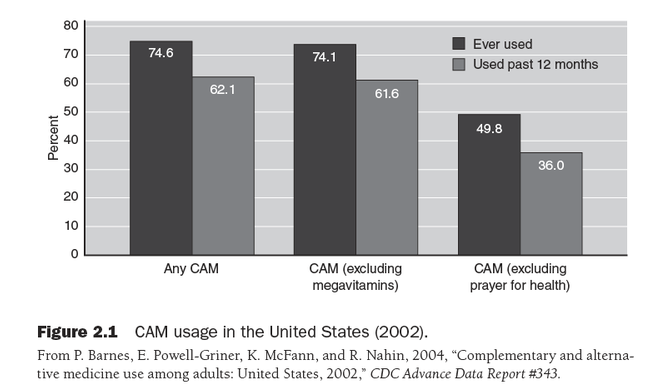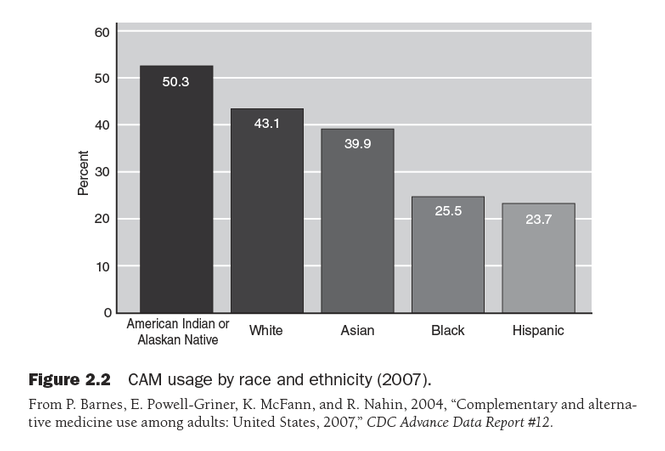Complementary and alternative medicine
This is an excerpt from Cultural Competence in Sports Medicine by Lorin Cartwright & Rene Shingles.
The National Center for Complementary and Alternative Medicine (NCCAM), located at the National Institutes of Health, is the leading agency for the U.S. government on scientific research into CAM (Spector, 2009). “CAM is a group of diverse medical and health care systems, practices, and products that are not presently considered to be part of conventional medicine” (National Center for Complementary and Alternative Medicine, 2007, p. 1). Conventional medicine consists of allopathy practiced by medical doctors (MDs), osteopathy practiced by doctors of osteopathy (DOs), and medicine practiced by their allied health professionals, such as athletic trainers, physical therapists, psychologists, and registered nurses. Allopathic medicine is based on proven, scientific methodology to determine value in the treatment of disease (Spector, 2009). Osteopathic medicine is “the art of curing without the use of surgery or drugs . . . and take[s] into account the relationship between body structure and organ functioning” (Spector, 2009, p. 97) when determining a diagnosis. Complementary medicine is used in conjunction with or in addition to conventional medicine; for example, aromatherapy may be used in addition to other medicines to help decrease a patient's discomfort following surgery. On the other hand, alternative medicine is used in place of or as a substitute for conventional medicine. An example of an alternative therapy is treating cancer by using a special diet or herbal medicine instead of undergoing radiation or chemotherapy (both of which are conventional approaches) recommended by a medical or osteopathic doctor. Integrative medicine “combines conventional and CAM treatments for which there is evidence of safety and effectiveness” (National Center for Complementary and Alternative Medicine, 2007, 2009a; Spector, 2009).
In 2002, a national survey revealed that 36 percent of adults in the United States used a form of CAM. When the definition of CAM included megavitamin therapy and prayer for health reasons, the number rose to 62 percent (Barnes, Powell-Griner, McFann, & Nahin, 2004), and Blacks, followed by Asians, were the most likely to use CAM defined in this way. Asians were also more likely to use CAM when megavitamin therapy and prayer were not included (figure 2.1), and women were more likely users than men (Barnes, Powell-Griner, et al., 2004).

Intercollegiate student athletes have been reported to use CAM at a higher rate than that of U.S. adults generally; specifically, student athletes most commonly used massage (38 percent), followed by chiropractic medicine (29 percent), lomilomi (a type of massage that combines prayer, breathing, and energy; 14 percent), and acupuncture (12 percent) (Nichols & Harrigan, 2006).
By 2007, the number of adults surveyed using CAM had risen to 38 percent, and the number of children using CAM was reported as 12 percent (Barnes, Bloom, & Nahin, 2008). Specifically, 50 percent of American Indian or Alaska Native, 43 percent of White, 40 percent of Asian, 26 percent of Black, and 24 percent of Hispanic adults used CAM. American Indian or Alaska Native and White adults were more likely to use CAM than Asian and Black adults (figure 2.2) (Barnes, Bloom, & Nahin). Women were still more likely to use CAM than were men, and people with higher levels of education and higher income were also more likely users.

According to NCCAM (2007), CAM practices involve four domains (some of which overlap) and several whole medical systems that cut across each of the Asian domains. The four domains are mind-body medicine, biological-based practices, manipulative and body-based practices, and energy medicine. Whole medical systems, which are comprehensive health care systems based on theory and practice, include (from Eastern cultures) traditional Chinese medicine (TCM) and the Asian Indian practice of Ayurveda and (from Western culture) homeopathic medicine and naturopathic medicine. What constitutes CAM practices continues to be an evolving definition. As some practices are deemed to be safe and effective by Western medical standards, they may be adopted as conventional medical practices. Likewise, new practices emerge. Some CAM practices, such as acupuncture for knee osteoarthritis (Berman et al., 2004), are supported by some scientific evidence. However, further research is necessary to determine efficacy and safety—as, for example, in the ongoing clinical trials on the use of echinacea for colds (Turner, Bauer, Woelkart, Hulsey, & Gangemi, 2005).
Athletic trainers need to become familiar with the differing CAM practices, determine the extent to which their patients are using such practices, and understand how CAM practices affect patient care and treatment. For example, if a particular CAM practice (e.g., massage) does not interfere with the treatment that the athletic trainer wishes to prescribe, then no cultural conflict arises, and the treatment should be allowed. If, however, the CAM practice is contraindicated, or will interfere with the athletic trainer's treatment plan, then the athletic trainer, the patient, and a CAM practitioner (if involved) should discuss treatment efficacy and determine the best course of action.
Mind-Body Medicine
Mind-body medicine “uses a variety of techniques designed to enhance the mind's capacity to affect bodily function and symptoms” (NCCAM, 2007, p. 2). Intervention strategies such as patient support groups and cognitive behavioral therapy have been adopted into conventional medical practices and are used to promote health. Examples of mind-body medicine include meditation, yoga, tai chi, qigong (pronounced /chee-GUNG/)—which are common in Asia—and prayer (NCCAM, 2007); more specifically, qigong, a practice similar to tai chi, combines movement, meditation, and controlled breathing to enhance the flow of energy in the body (NCCAM, 2009b). When prayer is included in the definition, mind-body medicine is the most commonly used CAM practice in the United States. In fact, in 2002, 53 percent of Americans used mind-body medicine (Barnes, Powell-Griner, et al., 2004). Among adults, the use of several mind-body medicine therapies has increased between 2002 and 2007—deep breathing from 11.6 percent to 12.7 percent, meditation from 7.5 percent to 9.4 percent, and yoga from 5.1 percent to 6.1 percent (Barnes, Bloom, & Nahin, 2008). Among adolescents, prayer was the third most common CAM practice used to treat asthma (Reznik, Ozuah, Franco, Cohen, & Motlow, 2002). In addition, “mind-body therapies have been applied to and studied for various types of pain. Results from clinical trials indicate that mind-body therapies may be effective additions to the treatment and management of arthritis, including rheumatoid arthritis and its pain” (NCCAM, 2005, no page given). However, more research is needed to determine which therapies are effective and how those work.
Biological-Based Practices
When prayer is not included, biological-based practices are the most commonly used CAM approaches in the United States (used by 27 percent of Americans) (Barnes, Bloom, & Nahin, 2008; Barnes, Powell-Griner, et al., 2004). Biological-based practices consist of herbs, foods, and vitamins found in nature; examples include the use of dietary supplements and herbal products, as well as aromatherapy. Among adults in 2007, the five most commonly used natural products were fish oil (omega-3 fatty acids), glucosamine, echinacea, flaxseed oil or pills, and ginseng (Barnes, Bloom, & Nahin). The most commonly used items among college athletes were creatine products, protein, and amino acids; the use of ephedrine, or herbs containing ephedrine (e.g., ma huang), has declined since 2002, when the National Collegiate Athletic Association began testing for the substance (Hosick, 2005).
More Excerpts From Cultural Competence in Sports MedicineSHOP

Get the latest insights with regular newsletters, plus periodic product information and special insider offers.
JOIN NOW
Latest Posts
- Sample mental health lesson plan of a skills-based approach
- Sample assessment worksheet for the skill of accessing valid and reliable resources
- Help your students overcome what holds them back from making health-promoting choices
- Example of an off-season microcycle
- Modifying lifts
- Screening for multilevel programs in a team environment


